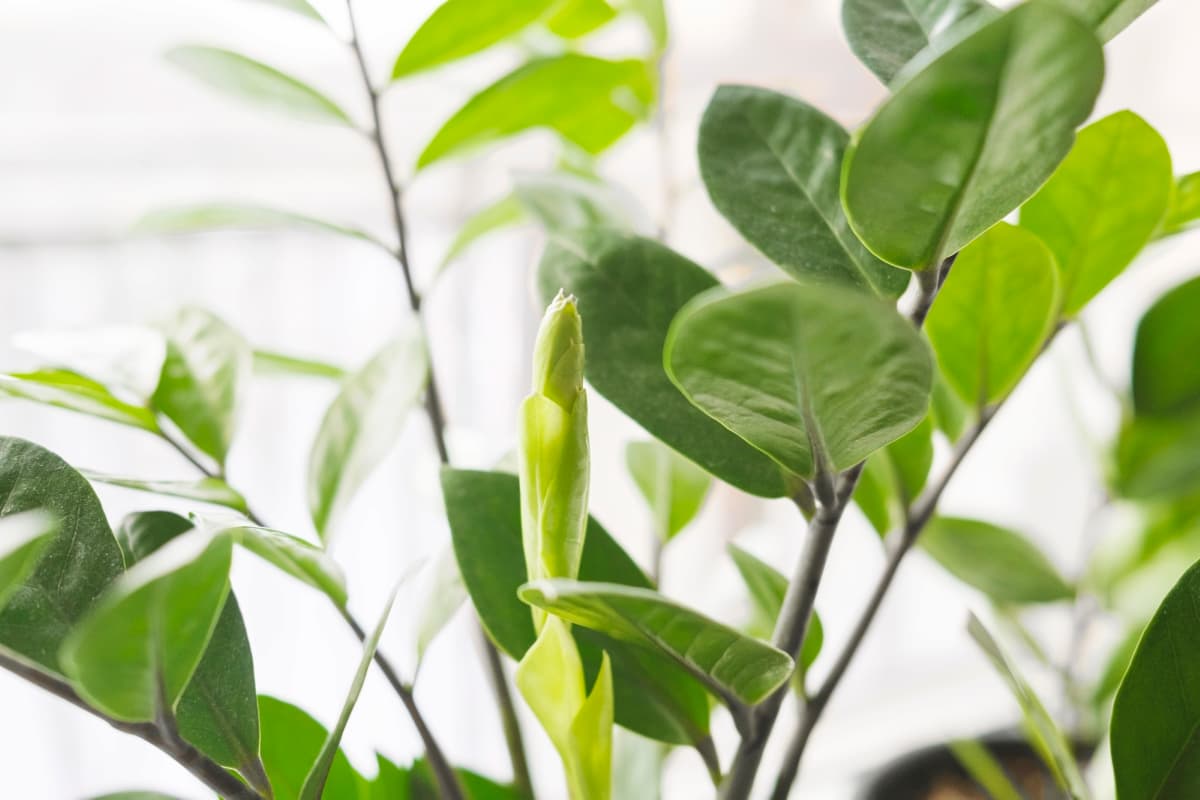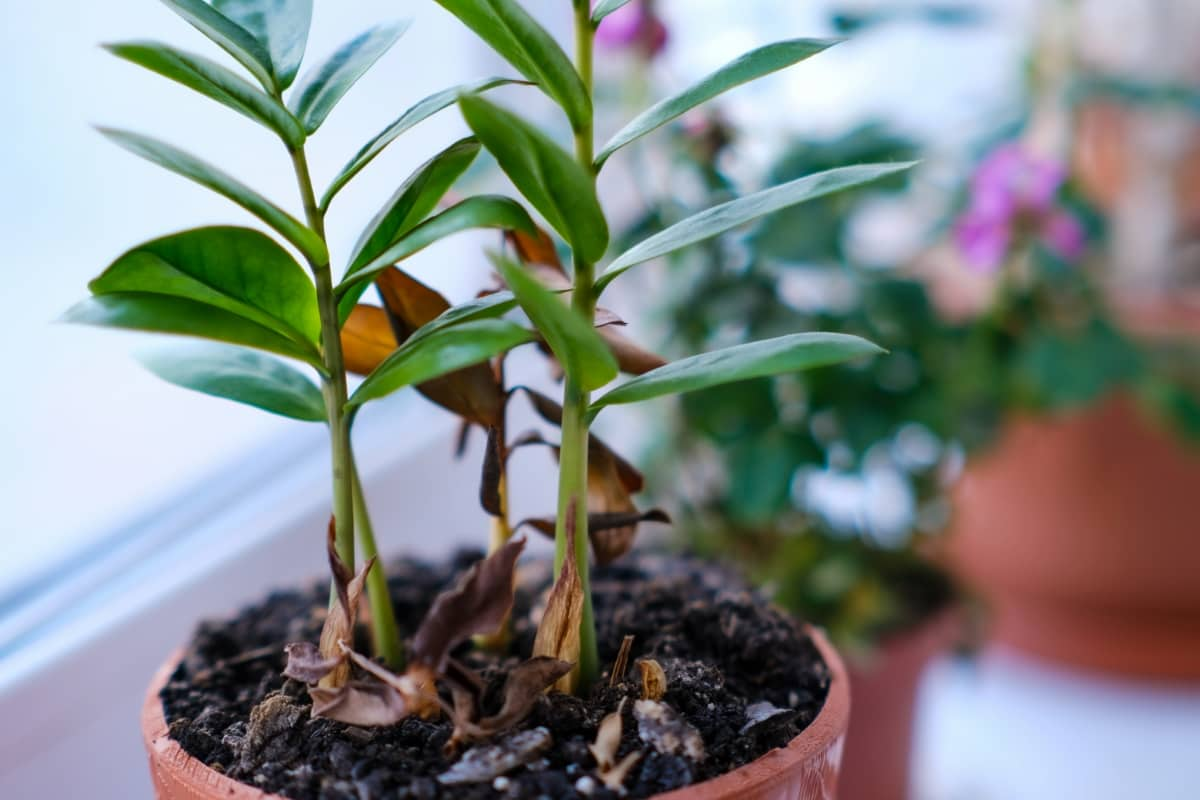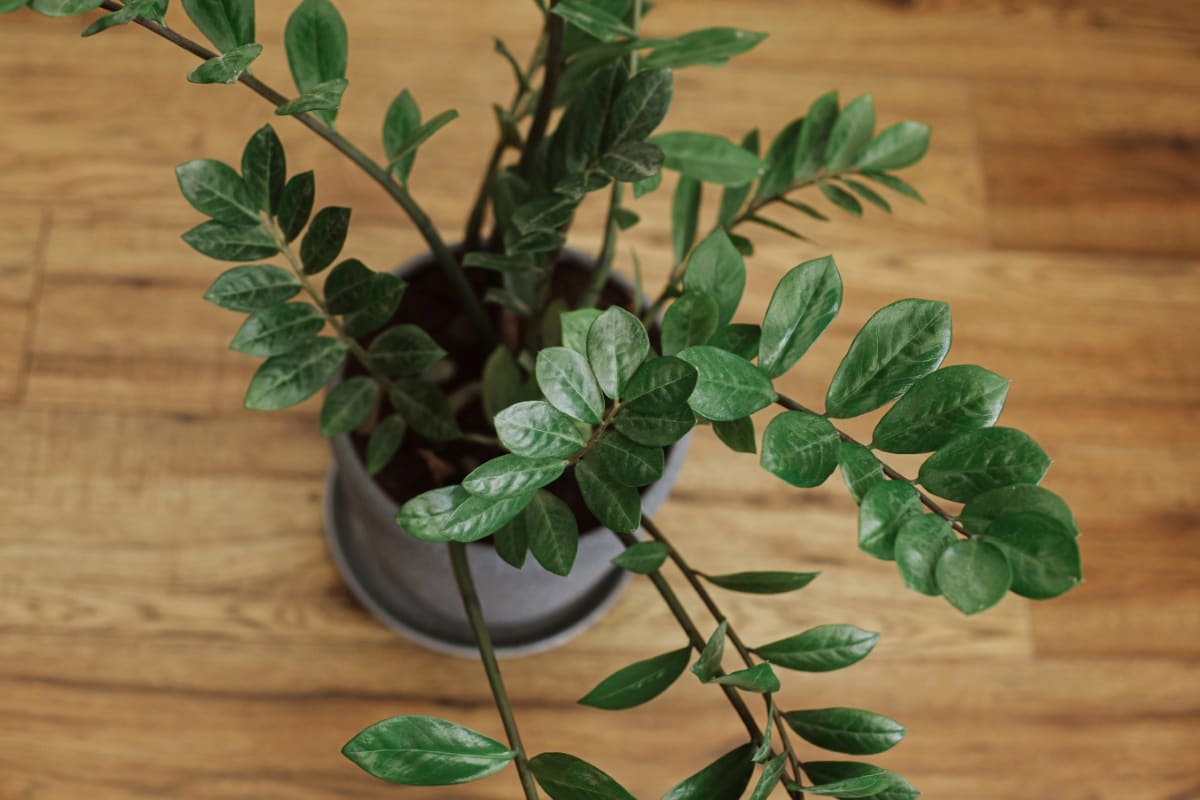ZZ plants, known as Zamioculcas Zamiifolia, are captivating houseplants with glossy deep green leaves. They are loved for their ability to thrive in low-light conditions and require minimal care. However, these beautiful plants can sometimes develop brown spots on their leaves, which can be unsightly and indicate an underlying issue. How do I get rid of brown leaves on my ZZ plant? Providing your ZZ plant with the appropriate amount of light help prevent brown spots from forming and ensure that its beautiful foliage remains vibrant and healthy.

How to Treat Brown Spots on ZZ Plant Leaves
Causes of Brown Spots on ZZ Plant Leaves
One possible cause of brown spots on ZZ plant leaves is overexposure to sunlight. These plants are known for their ability to thrive in low-light conditions, so placing them in direct sunlight or giving them too much light could lead to brown spots appearing on the stems and eventually spreading onto the leaves. Another reason behind those unsightly brown spots could be a lack of humidity. ZZ plants naturally originate from regions with high humidity levels, so when grown indoors with dry air, they may struggle with maintaining optimal moisture levels.
Why are my ZZ Plant Leaves Turning Brown? Improper watering practices can also lead to brown spots on ZZ plant leaves. While these plants enjoy drying out between waterings and have succulent-like characteristics that allow them to tolerate periods without moisture well, neglecting watering sessions for extended periods will undoubtedly result in stress and visible signs such as browning foliage. It’s crucial to strike a balance by allowing the soil surface to dry before giving it another thorough watering session.
Natural Remedies for Brown Spots on ZZ Plant Leaves
- One effective remedy is to increase the humidity around the plant. You can achieve this by misting the plant leaves or placing a pebble tray filled with water near the plant.
- Another simple remedy is to ensure proper watering. While ZZ plants prefer to dry out between waterings, it’s important not to neglect them completely. Make sure you’re giving your plant just enough water without overdoing it.
- Inspect your ZZ plant for any signs of pests or diseases that may be causing the browning of leaves. If necessary, treat these issues accordingly using organic pest control methods.
In case you missed it: How to Grow and Care for ZZ Plants: Planting Instructions

Effective Home Remedies to Treat Brown Spots on ZZ Plant Leaves
One simple remedy is gently wiping the affected leaves with a damp cloth. This will help remove any dirt contributing to the discoloration. Another way is to mix a solution of equal parts water and milk, then spray it onto the leaves using a spray bottle. The lactic acid available in milk has natural bleaching properties that can fade brown spots over time. Additionally, you can create a homemade fertilizer by mixing coffee grounds with water and then applying it directly to the soil around your ZZ plant.
Coffee grounds contain beneficial nutrients like nitrogen and potassium, promoting healthy leaf growth and minimizing browning. Another effective remedy involves creating a natural insecticide using ingredients like neem oil or dish soap mixed with water. Spray this solution onto your plant’s leaves, covering both sides thoroughly. This will help eliminate any pests causing damage and leading to brown spots.
How to Naturally Fix Brown Spots on ZZ Plant Leaves?
- One simple solution is to adjust the lighting conditions for your ZZ plant. These plants thrive in low-light environments, so too much direct sunlight can cause those unsightly brown spots. Consider moving your plant to a darker spot in your home or office.
- In addition to light and humidity adjustments, proper watering is crucial for maintaining healthy ZZ plants. While they do like some drying out between waterings, ensure you’re not neglecting them completely. Water thoroughly when the top inch of soil feels dry, but avoid overwatering as it can lead to root rot.
- Furthermore, eyeing for pests is essential in naturally preventing brown spots on ZZ plant leaves. Pests like spider mites or mealybugs can damage foliage and create browning patches. Regularly inspect both sides of leaves and stems for any signs of pest infestation. Take appropriate measures such as using insecticidal soap or wiping affected areas with rubbing alcohol-soaked cotton swabs.
- Consider fertilizing your ZZ plant every few months during its active growing season (spring through summer) to ensure it receives sufficient nutrients for healthy leaf growth.
Home Remedies for Treating Brown Spots on ZZ Plant Leaves
- Aloe Vera Juice: Apply fresh aloe vera juice directly onto the brown spots. It has soothing properties that can promote healthier leaf growth.
- Cinnamon Powder: Mix cinnamon powder with water to make a paste, then apply it to the affected areas. Cinnamon is known for its antifungal properties, which can help combat any fungal infections causing the brown spots.
- Chamomile Tea: Brew chamomile tea and allow it to cool completely. Then, use a cotton ball soaked in the tea to wipe down the leaves of your ZZ plant gently. Chamomile has anti-inflammatory properties that can soothe stressed leaves.
- Epsom salt: Dissolve 1 tablespoon of Epsom salt in 1 gallon of water and use this solution to water your ZZ plant every two weeks until you see improvement in the brown spots.
- Organic fungicide: Use an organic fungicide spray specifically formulated for houseplants according to package instructions to treat any underlying fungal issues causing the browning of leaves.
In case you missed it: How to Grow ZZ Plant from Cuttings: DYI in 10 Simple Steps

DIY Treatments for Brown Spots on ZZ Plant Leaves
- One effective remedy is to create a mixture of water and dish soap. Wipe the affected leaves with a soft cloth soaked in this solution, careful not to rub too harshly.
- Another DIY treatment involves using a diluted hydrogen peroxide solution. Mix 1 hydrogen peroxide with 3 parts of water and spray it onto the affected areas. This will help eliminate any fungal or bacterial infections causing the brown spots.
- Alternatively, you can use neem oil with natural antifungal and antibacterial properties. Dilute neem oil in water according to package instructions and apply it to the affected leaves using a spray bottle or cotton swab.
- Ensure proper watering practices by allowing the soil to dry out between waterings and providing adequate drainage for your ZZ plant. Regularly inspecting your plant for pests and promptly addressing any issues can also prevent brown spots from occurring.
Natural Ways for Brown Spots on ZZ Plant Leaves
- Adjust Lighting: ZZ plants prefer bright, indirect light, so they’re not exposed to direct sunlight or harsh artificial lighting. Move them to a spot where they receive moderate amounts of filtered light throughout the day.
- Humidity Control: ZZ plants thrive in environments with moderate humidity levels. Consider placing a tray with water near your plant to maintain optimal moisture levels.
- Avoid Drafts: ZZ plants don’t appreciate chilly drafts or sudden temperature fluctuations, which can cause stress and leaf discoloration. Keep them away from doors, windows, and HVAC vents.
- Clean Leaves Regularly: Dust build-up on leaves can hinder photosynthesis and contribute to brown spots. Gently wipe down the foliage with a soft cloth or use a mild leaf cleaner for better air circulation.
- Fertilize Wisely: Too much fertilizer can lead to salt build-up in the soil, causing burn marks on leaves over time. Use a balanced liquid fertilizer diluted per package instructions every few months during the growing season.
In case you missed it: Mulch for Indoor Plants: Benefits and Disadvantages

Conclusion
Brown spots on ZZ plant leaves can be quite concerning for plant enthusiasts. These spots are areas where the leaf tissue has undergone damage or decay, resulting in light-brown to dark-brown discoloration. ZZ plants are versatile and adaptable indoor companions that bring life and beauty into any setting without demanding too much attention.
- Feed Your Flock for Less: Top 10 Tips to Save on Chicken Feed
- Ultimate Guide to Ossabaw Island Hog: Breeding, Raising, Diet, and Care
- Hatching Answers: The Top 10 Reasons Your Chickens Aren’t Laying Eggs
- Eggs and Economics: Breaking Down the Cost of Raising Backyard Chickens
- Defend Your Greens: Proven Methods to Keep Iguanas Out of Your Garden
- Ultimate Guide to Cinnamon Queen Chicken: A Comprehensive Guide for Beginners
- Ultimate Guide to California Tan Chicken: Breeding, Raising, Diet, Egg-Production and Care
- Ultimate Guide to Marsh Daisy Chicken: Breeding, Raising, Diet, and Care
- 10 Types of Chicken Farming Businesses You Can Start for Profits